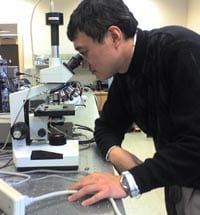The popular web site Softpedia has written about SMU’s new “world’s fastest integrated circuit” designed for use in the challenging environment of the Large Hadron Collider.
The circuit was designed by physicists in SMU’s Department of Physics. Softpedia science editor Tudor Vieru writes about the major advancement in an April 9 post “LHC to Receive Fastest Integrated Circuits Ever Made.”
The popular web site Softpedia has written about SMU’s new “world’s fastest integrated circuit” designed for use in the challenging environment of the Large Hadron Collider.
The circuit was designed by physicists in SMU’s Department of Physics. Softpedia science editor Tudor Vieru writes about the major advancement in an April 9 post “LHC to Receive Fastest Integrated Circuits Ever Made.”
 |
| Jingbo Ye views SMU LOC serializer |
The site, popular for software downloads and science and technology information, noted that the job of the new high-speed integrated circuit was designed for the LHC’s high-radiation environment, as well as for high data bandwidth, low-power dissipation and extremely high reliability. SMU physicist Jingbo Ye, an associate professor of physics, led development of the circuit.
Excerpt:
By Tudor Vieru
Science Editor
A group of experts from the Southern Methodist University (SMU), in Dallas, announces the development of a new, super-fast circuit designed specifically to augment the capabilities of one of the main particle detectors of the Large Hadron Collider. The LHC is the largest physics experiment ever designed, and its goal is to discover some of the most fundamental knowledge about the Universe and the elementary particles and forces that govern our world.With the development of the new integrated circuits, called “link-on-chip” or LOC serializer circuits, the team hopes to be able to boost the performances of the LHC’s ATLAS particle detectors, one of the three main instruments in the 27-kilometer-long tunnel of the accelerator. The innovation was designed specifically to be used by the Liquid Argon Calorimeter, an ATLAS sub-detector that could function a lot better, and overall more efficiently, once the new application-specific integrated circuits (ASIC) are added. The SMU team is directly involved in the ATLAS collaboration.
There was a large number of factors researchers at the university needed to consider when creating the LOC. In addition, the large amount of radiation that is produced as the LHC collides beams of protons head-on at the highest energy levels ever achieved, there are also other issues to consider. The calorimeter needs to be able to handle a high data bandwidth, low power dissipation, and must feature an extremely high degree of reliability as well. There is very little room for error in an endeavor such as the LHC, and all of its components need to respect a vast array of norms and rules.
 The popular web site
The popular web site